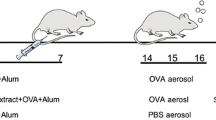Abstract
Epidemiological and experimental studies have demonstrated an association between parasitic infections and the allergic diseases. A protective effect in asthma was shown in animals infected with helminths. The aim of this study was to determine the effect of Angiostrongylus costaricensis extract on inflammatory lung response to ovalbumin (OVA) in mice. Four BALB/c mice received A. costaricensis extract by intraperitoneal (i.p.) injection on the first day. Mice were immunised against OVA by i.p. injection on day (D) 5 and D12 and received a daily intranasal OVA challenge (40 μl) between the D19 and D21. On D23, we performed a bronchoalveolar lavage (BAL) on the mice. Four BALB/c mice (control group) were immunised against OVA using the same protocol, but did not receive parasite extract. Total cell counts (TCC) and differential cell counts were performed in BAL fluid samples. Eosinophil cell counts in BAL fluid were lower in the group that received A. costaricensis extract when compared with the control group (0.04×106 cells/ml and 0.01×106 cells/ml, respectively; p=0.04). TCC were not different between the groups studied. A. costaricensis extract in mice decreases eosinophilic response to OVA in BAL fluid.

Similar content being viewed by others
References
Akdis CA, Kussebi F, Pulendran B et al (2003) Inhibition of T helper 2-type responses, IgE production and eosinophilia by synthetic lipopeptides. Eur J Immunol 33:2717–2726
Britton J (2003) Parasites, allergy, and asthma. Am J Respir Crit Care Med 168:266–267
Geiger SM, Abrahams-Sandi E, Soboslay PT et al (2001) Cellular immune responses and cytokine production in BALB/c and C57BL/6 mice during the acute phase of Angiostrongylus costaricensis infection. Acta Trop 80:59–68
Graeff-Teixeira C, Camillo-Coura L, Lenzi HL (1991) Clinical and epidemiological aspects of abdominal angiostrongyliasis in Southern Brazil. Rev Inst Med Trop Sao Paulo 33:373–378
Huang SL, Tsai PF, Yeh YF (2002) Negative association of Enterobius infestation with asthma and rhinitis in primary school children in Taipei. Clin Exp Allergy 32:1029–1032
Lima C, Perini A, Garcia ML, Martins MA, Teixeira MM, Macedo MS (2002) Eosinophilic inflammation and airway hyper-responsiveness are profoundly inhibited by a helminth (Ascaris suum) extract in a murine model of asthma. Clin Exp Allergy 32:1659–1666
Lynch NR, Hagel I, Perez M, Di Prisco MC, Lopez R, Alvarez N (1993) Effect of anthelmintic treatment on the allergic reactivity of children in a tropical slum. J Allergy Clin Immunol 92:404–411
Medeiros M, Jr., Figueiredo JP, Almeida MC et al (2003) Schistosoma mansoni infection is associated with a reduced course of asthma. J Allergy Clin Immunol 111:947–951
Palmas C, Gabriele F, Conchedda M, Bortoletti G, Ecca AR (2003) Causality or coincidence: may the slow disappearance of helminths be responsible for the imbalances in immune control mechanisms? J Helminthol 77:147–153
Pinto LA, Pitrez PM, Fontoura GR et al (2004) Infection of BALB/c mice with Angiostrongylus costaricensis decreases pulmonary inflammatory response to ovalbumin. Parasite Immunol 26:151–155
Ubelaker JE (1986) Systematics of species referred to the genus Angiostrongylus. J Parasitol 72:237–244
van den Biggelaar AH, van Ree R, Rodrigues LC et al (2000) Decreased atopy in children infected with Schistosoma haematobium: a role for parasite-induced interleukin-10. Lancet 356:1723–1727
von Mutius E, Martinez FD, Fritzsch C, Nicolai T, Roell G, Thiemann HH (1994) Prevalence of asthma and atopy in two areas of West and East Germany. Am J Respir Crit Care Med 149:358–364
Weiss ST (2000) Parasites and asthma/allergy: what is the relationship? J Allergy Clin Immunol 105:205–210
Weston-Davies W, Nuttall P (2002) Parasite saliva as a source of antiallergic agents. Lancet 359:1067
[No authors listed] (1998) Worldwide variation in prevalence of symptoms of asthma, allergic rhinoconjunctivitis, and atopic eczema: ISAAC. The International Study of Asthma and Allergies in Childhood (ISAAC) Steering Committee. Lancet 351:1225–1232
Zhu Z, Zheng T, Homer RJ et al (2004) Acidic mammalian chitinase in asthmatic Th2 inflammation and IL-13 pathway activation. Science 304:1678–1682
Acknowledgements
The authors wish to thank their colleagues from the Laboratory of Molecular Parasitology and the Laboratory of Pulmonology for their helpful comments and participation. The experiment complies with the current ethic laws of Brazil.
Author information
Authors and Affiliations
Corresponding author
Rights and permissions
About this article
Cite this article
Pinto, L.A., Dias, A.C.O., Rymer, B.L. et al. Effect of Angiostrongylus costaricensis extract on eosinophilic pulmonary response in BALB/c mice. Parasitol Res 98, 295–298 (2006). https://doi.org/10.1007/s00436-005-0042-6
Received:
Accepted:
Published:
Issue Date:
DOI: https://doi.org/10.1007/s00436-005-0042-6




